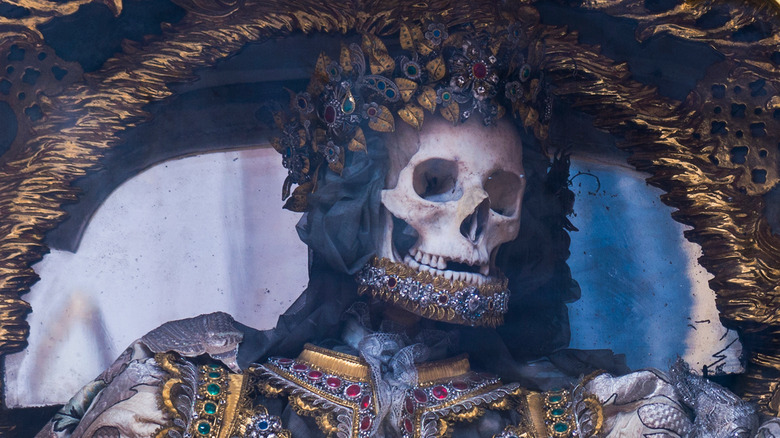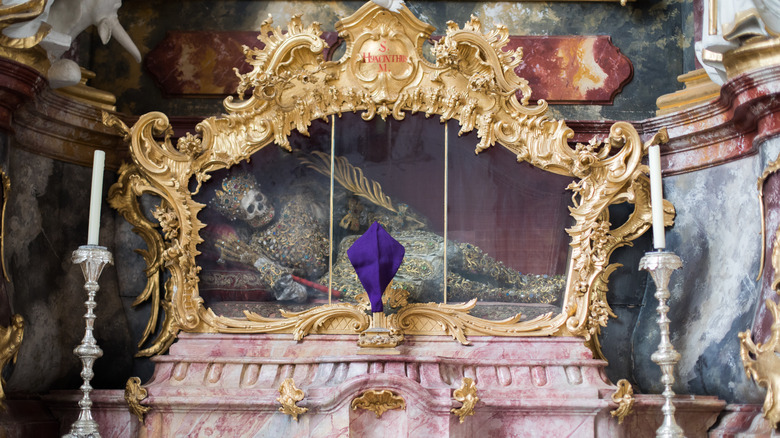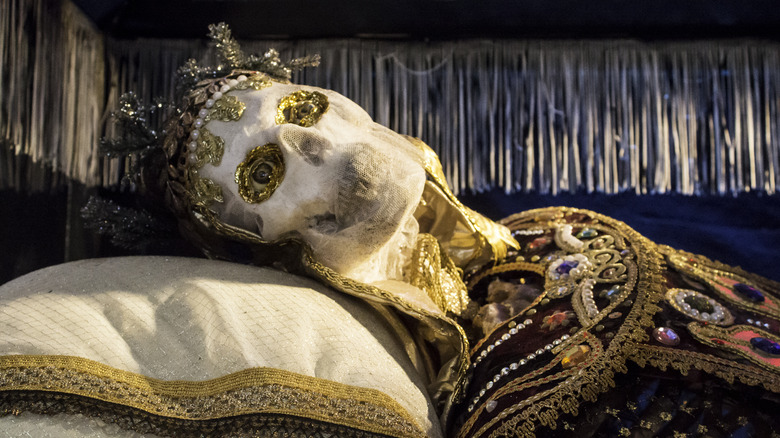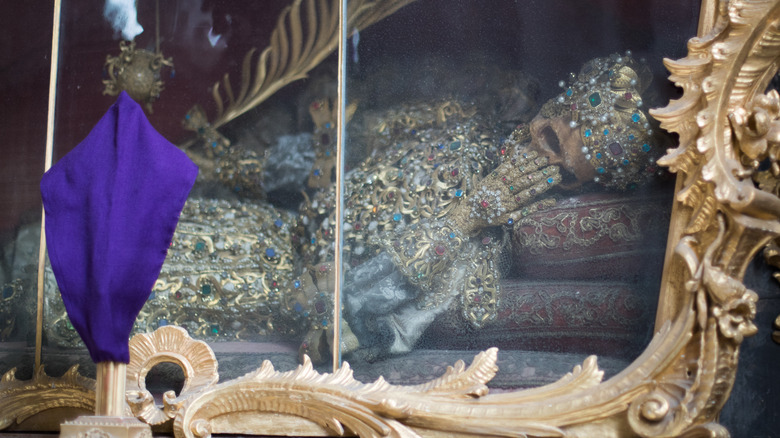
Andreas Wolochow/Shutterstock
In the 16th century, Europe underwent a religious fracturing, which brought the idea of a united Latin Christendom to an end. It started with the iconic figure Martin Luther and his "95 Theses" posted to the church doors in Wittenberg, Germany, as reported by Britannica. But, in truth, dissenters had long been criticizing the excesses of the Catholic Church and its vice-like financial grip on Europe. These included men like the 15th-century Jan Hus who perished unrepentant in the flames of a heretic's fire after defending his views at the Council of Constance (via Britannica).
Although many parts of Europe remained squarely under the Vatican's control, the Reformation led to conflicts and bloodshed in Northern Europe and the British Isles. It would have a terrible impact on France, too, with the massacre of Huguenots (French Protestants) on St. Bartholomew's Day in 1572, according to Britannica.
The last thing the pope and church officials wanted was a religious power vacuum, so they launched a Counter-Reformation, which helped to usher in the Baroque era with its highly emotional religious artwork, per Counter-Reformation and Baroque. The Vatican reasoned that passionate examples of religious devotion would inspire people to return to the church. This extended to the dissemination of thousands of new relics, including the elaborately jeweled skeletons of so-called martyrs. Here's the story of the mysterious and enigmatic bejeweled bones and where you can find them today.
The skeletons were discovered in the 16th century
In 1578, vineyard workers stumbled across a hidden entrance to the Roman catacombs, wandering into subterranean chambers containing between 500,000 and 750,000 dead bodies, per Smithsonian Magazine. Although some pagan and Jewish remains also lay in the catacombs, the vast majority were Christian with some dating back to periods of Roman persecution. In other words, the chambers contained the potential for uncovering new relics in the form of martyr bones, per CNN Style.
Officials from the Catholic Church disinterred thousands of skeletons, claiming them as early Roman martyrs. Although the methods for identifying these alleged saints proved dubious at best, the faithful never second-guessed the church's official narrative about them. For good measure, church officials decorated these excavated skeletons, creating opulent masterpieces. They spared no expense in elevating human remains from archaeological subjects to what author and photographer Paul Koudounaris terms "heavenly bodies" in his 2013 book "Heavenly Bodies: Cult Treasures & Spectacular Saints from the Catacombs."
Housed in golden clothing, these strange skeletal figures dripped with silk mesh and precious stones and metals, from their eye sockets to their teeth, according to Atlas Obscura. The over-the-top ornamentation remained unmatched by previous relics and reliquaries, creating what can only be described as glamorous commemorations of the sacred dead (via Our Paranormal World). These stunning creations proved awe-inspiring for believers, but not everybody liked them.
They replaced articles lost during the Reformation

Alexandru Nika/Shutterstock
In a Europe torn by religious wars, radical Protestant sects destroyed and plundered Catholic churches (via Our Paranormal World). In response, the Catholic Church launched the Counter-Reformation, seeking to restore the splendor of Catholicism in Protestant strongholds, per Patrick Preston's paper Counter-Reformation and Baroque.
Chief among Counter-Reformation activities was the removal and adornment of human remains from the Roman catacombs, dispersing them to churches and communities throughout the continent. The Counter-Reformation's ultimate goal remained "to influence the audience and to produce an emotional rather than a rational response" (via Patrick Preston). To achieve these ends, the nuns and monks who decorated the bones attempted to overwhelm the audience with their sparkling wealth.
Not only did these objects inspire believers, but they also represented ostentatious replacements for stolen or destroyed church relics, according to Smithsonian Magazine. Soon, an army of glittering skeletons descended on the most fought over parts of Europe. They followed pathways made by waves of iconoclasm, attested by razed churches and shattered sculptures, per Duke University and Tufts University. Mobs had destroyed these sacred objects because they perceived them as idols in the wake of new teachings. Protestantism hinged on the concept of a personal relationship with God, which meant any physical intermediary between humans and God, whether it be priests or relics, marked a barrier rather than a bridge. But the Catholic Church remained stalwart in its stance, using jeweled skeletons to proclaim, "We're coming back bigger and better than ever."
The skeletons communicated the splendors of the afterlife

high fliers/Shutterstock
The elaborately decorated catacomb skeletons conveyed the splendor and opulence that awaited faithful individuals in the afterlife, per CNN Style. Of course, communicating the richness of paradise represented quite an undertaking. It could take skilled artisans, often working in teams, up to three years to complete. Once finished, the best of these gold and jewel-encrusted skeletons elicited awe and reverence.
For those wondering what the afterlife had to do with precious jewels and metals, the Bible provides fascinating answers. Revelation 21:19-20 describes heaven as a city, saying, "The foundations of the wall of the city were adorned with all kinds of precious stones." It goes on to list a wide variety of gemstones involved in the construction of the city, including sapphires, jaspers, chalcedonies, emeralds, topazes, and amethysts. In the context of this passage, bling-y bones made sense.
In essence, church officials offered up the glittering skeletons as symbols of the rewards available in the next life, per Our Paranormal World. But while Catholics saw these skeletons as inspiring, Protestants felt repulsed by them. In their eyes, the bones represented everything wrong with Catholicism. In a Europe crippled by poverty among the lowest classes, the ostentatious nature of these relics appeared downright wasteful and insulting.
They trended in places hard-hit by the Reformation
During the 16th century, jeweled skeletons proved all the rage — the more elaborate, the better, according to Smithsonian Magazine. Catholic churches across Europe vied for them, no matter how small their congregations, because they represented a "grandiose statement" sure to draw a crowd and cause a stir of religious fervency.
Jeweled skeletons proved especially popular in southern Germany, which had endured the full brunt of the Protestant Reformation. Anti-Catholic sentiments had swept through the region, fueling sacred object destruction on a large scale. As a result, these areas had suffered a dearth of religious relics, and the demoralization that went with it.
Understanding the physical and psychological impact of these events, the Vatican scrambled to fill the void. In the process, they hoped to restore the church's standing, reputation, and power worldwide. The discovery of the Roman catacombs provided a simple and straightforward answer with a near-endless supply of ancient human remains. Nobody was there to police the skeleton recovery process, and die-hard Catholics didn't question the authenticity of the fancy-looking bones they received. This made disseminating decorated bones a fantastic way to improve morale and fortify the resolve of those still clinging to their Catholic roots.
Affluent families wanted them, too
Besides churches, wealthy families acquired decorated remains for private chapels, according to Smithsonian Magazine. Fraternities and guilds also pooled their resources to get their hands on bejeweled skeletons, which acted as potent visual reminders of their patron saints. Soon, the demand for crypt beauties reached a feverish pitch with public and private spaces vying equally for them.
The history of private chapels owned by affluent families is a particularly fascinating one as detailed by the Huffington Post. Once seen as a necessary part of any family estate, they not only demonstrated a family's devotion to the faith but also their influence within the church. Private chapels complete with a fully decked out saint's skeleton represented the be-all, end-all for families looking to promote their prestige. In a sense, these displays demonstrated the church's legitimization of these families even as the displays showed the family's entrenchment within Catholicism.
As for guilds and fraternities, they also had a long history of patron saints, as detailed by Tradition in Action. For example, Crispin was the patron saint of cobblers, and Eloy the patron saint of craftsmen starting in the 800s A.D. Perfume sellers turned to Mary Magdalene to intercede on their behalf. So, you can imagine the boon it meant for craftsmen and artisans alike to ascertain a relic from the saint who oversaw their profession. As for getting a hold of a fully decorated skeleton, it marked an incomparable achievement, sure to bless their life labors.
They represented a money-making venture
Although the Vatican sent out thousands of decorated human remains, small churches, private families, and guilds still had to go to great lengths to gain access to them, according to Smithsonian Magazine. As the frenzy for saints' bones continued to grow, demand proved intense. But creative people found workarounds to ensure their place at the top of the jeweled skeleton list.
Perhaps the easiest way to get their hands on some bones was by knowing the right people in Rome. Although you might assume we're talking about high-ranking church officials here, think again. The most useful connections came through the papal guard. Where strong connections lacked, bribery worked, too. Plenty of palms got greased to ensure a jeweled skeleton arrived on various churches' and chapels' doorsteps.
After connections were made or the right people softened up with a little money, the order for a saintly body received confirmation. After the confirmation of a given order, Rome made preparations to have a decorated corpse sent to Northern Europe. The bodies were moved by monk couriers who specialized in this ghoulish trafficking. Not surprisingly, these individuals made bank through their efforts to provide dead saints safe passage across the continent.
The lands that loved jeweled skeletons

Alexandru Nika/Shutterstock
Of the nations most obsessed with these expensive and elaborate relics, Switzerland, Austria, and Germany ranked near the top (via Smithsonian Magazine). All told, the Catholic Church arranged to have at least 2,000 fully articulated and gilded skeletons transported to churches and organizations in these nations.
These geographic hotspots aren't a surprise when you consider the continued pressure they felt from the Protestant Reformation. Besides Martin Luther in Germany, Huldrych Zwingli, a priest turned reformer, put pressure on officials in Switzerland, per Britannica. Zwingli advocated for a return to Biblical teachings, which caught on with the lower classes as well as the burgeoning middle class living in cities.
According to Britannica, the Protestant movement had also swept through Austria in a frighteningly fast fashion from Catholic leaders' point of view. While these Protestant movements had differences, they all focused on the simplification of religious ceremonies, a return to the Bible, and the end of over-the-top visuals (like jeweled skeletons). But the Catholic Church remained stalwart in its stance that the Reformation must be fought with superior imagery, whether it be Baroque statues, canvases, or bones. Considering the rampant illiteracy that still plagued Europe, this approach appealed to many.
It was all about the packaging
The creation of decorated skeletons represented a dubious process that started with identifying the bones of martyrs in the catacombs (via Smithsonian Magazine). This process sometimes even relied on psychics who would walk through the catacombs going into trance-like states as they came across important bone assemblages.
Other means of identifying martyr bones included looking for a golden glow or smelling a faint though sweet perfume from ancient skeletons. Catholic Church officials argued both of these physical manifestations represented irrefutable and miraculous proof of divine favor. And when all else failed, they looked for engravings of the letter "M" next to bodies, reasoning this stood for "martyr." Unfortunately, one of the most popular names in ancient Rome also started with the letter "M," Marcus, making this approach haphazard.
Despite doubtful provenance, once the skeletons were identified as saintly bones, the church named which saints they represented and then set about preparing them for delivery. Once decorated, packaged, and sealed by the Vatican, churches never questioned their authenticity. In other words, it was all about the packaging of these supernatural individuals.
The decorations varied by convent and artisan
Over time, the artisan monks and nuns involved in decorating catacomb skeletons developed unique and recognizable styles (via Smithsonian Magazine). Their handiwork included elaborate textile work, lavish use of precious stones and jewelry, and, in some cases, full wax faces meant to endow the relic with a less scary and more lifelike appearance. Ironically, aging and cracking have rendered the skeletons with wax faces among the most horrific-looking examples of decked-out martyrs today.
The devotion invested into each martyr skeleton showed in the fine craftsmanship of its decorations, per CNN Style. Although the jewels and precious metals stand out the most, the textile work that protected each skeleton also proved impressive. Nuns had a reputation in Europe at that time for their cloth-making, beading, and lace-working abilities. The fragile silk mesh they spun got meticulously wrapped around each bone, protecting the skeletons from dust. To this, they added layers of beading and lace work as a fitting foundation for precious stones and metals. Saint Getreu's skeleton in Ursberg, Germany, represents an exemplary of their skills, according to Atlas Obscura.
Sometimes nuns decorated saintly fingers with their rings. And they clothed the bodies with garments donated by the nobility. They carefully cut peepholes into these clothes so the bones beneath remained visible. Other donated jewelry also decorated the bodies as well as finery purchased by taking up collections. These artisans of death developed unique styles that became the calling cards of their handiwork.
They inspired baby names
After a new catacomb martyr arrived in a town, locals celebrated its arrival in various ways, per Smithsonian Magazine. As with guild saints, towns saw their jeweled martyrs as city patrons, and they prepared for the miracles that would come with the introduction of the cherished dead.
Paul Koudounaris has written the book on Europe's catacomb treasures. In an interview with Smithsonian Magazine, he explained that the decorated remains "tended to be extremely popular because they were this very tangible and very appealing bridge to the supernatural."
To enhance the bridge between the community and local families, baby naming crazes took place after the arrival of a saint's body. Both the feminine and masculine versions of the same name took whole parishes by storm (via Our Paranormal World). Looking through old baptismal records reveals that, in some cases, up to half the children born in a given year bore a given saint's name. This naming practice also represented a means of protecting children by placing them under the care of the saint, which communities believed remained endowed with supernatural powers.
The skeletons weren't always anatomically correct
Although the nuns and artisans involved in crafting these relics proved highly skilled, they lacked formal artistic training, according to Smithsonian Magazine. They also had a limited understanding of anatomical matters. While this didn't take away from the artistic nature of their creations, it did lead to some creative skeletal re-articulation sure to drive a physical anthropologist insane.
Careful observers of the saintly bones today have noted a variety of egregious errors. These might include improperly connected remains. In other cases, bones might be missing or feet and hands might appear inappropriately scaled to the rest of the body. Of course, 16th-century devotees of the Catholic Church weren't sitting around with copies of "Grey's Anatomy," so these mistakes had little impact on the religious fervor such displays inspired.
But erroneous details do provide insight into the anonymous artisans that labored over them. It also demonstrates what these craftspeople had to work with in terms of knowledge and technique. And these mistakes demonstrate the importance of faith over factors such as scientific accuracy in a world still largely untouched by the Scientific Revolution and the empirical method.
The skeletons saw a dramatic reversal of fortunes
Over time, the skeletons transformed from revered relics into objects of derision and embarrassment (via Atlas Obscura). Once prized for their beauty and placed on display, they were secreted away and hidden due to the Enlightenment's changing views on religion and superstition, as reported by Our Paranormal World. Emperor Joseph II ordered that skeletons of undocumented provenance be purged, according to CNN Style. Those that survived the purging faced centuries of neglect.
But in recent years, the jeweled skeletons have become a point of fascination once more. Doubtful provenance aside, jeweled skeletons are enjoying a new currency today as fine art, per Smithsonian Magazine. After all, these macabre relics showcase skilled craftsmanship and antique embellishments that are both expensive and telling of the Baroque mindset of the Counter-Reformation.
People interested in checking out these Baroque masterpieces today often head to Waldsassen, Germany, where the local basilica is lined with 10 of these decorated Christian martyrs. Most have the air of nobility, dressed in elaborate costumes where no detail got overlooked or expense spared.